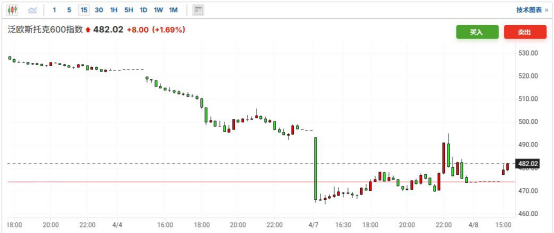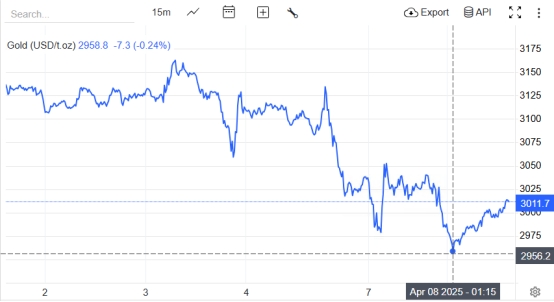EU's dual-track system fights back against Trump's tariff war: zero-tariff negotiations and countermeasures are launched simultaneously, and the gold market faces another risk aversion test
- 2025年4月10日
- Posted by: Macro Global Markets
- Category: News

EU's dual-track system fights back against Trump's tariff war: zero-tariff negotiations and countermeasures are launched simultaneously, and the gold market faces another risk aversion test

On April 8, Beijing time, the European Commission announced at an emergency trade ministers' meeting in Luxembourg that it would adopt a two-track response strategy of "soft and hard measures" to the Trump administration's "reciprocal tariff" policy: on the one hand, it would propose a "zero-to-zero" automobile tariff agreement to start negotiations; on the other hand, it would finalize the timetable for the first batch of countermeasures, demonstrating the game logic of "using peace to promote talks and using war to stop war."
Negotiation priority: offering a "zero tariff" olive branch
EU Trade Commissioner Šefčović said the EU has proposed a "zero tariff, zero barriers, zero subsidies" trade agreement on automobiles and industrial products to the United States, aiming to avoid a full-scale tariff war between the world's two largest economies. The proposal was promoted by German car companies and covered EU's advantageous industries such as automobiles, machinery, and chemicals, but was publicly refuted by US trade advisers, who said it "ignored the core demands of US manufacturing."
Ready to counter: 26 billion euros of tariff retaliation launched in stages
The EU made it clear that it "will not wait indefinitely for the results of the negotiations" and announced that its countermeasures will be implemented in two steps: April 15: launch the first batch of targeted tariffs, targeting US steel, agricultural products, visa and other goods, with a value of approximately 12 billion euros; May 15: implement the second batch of countermeasures, expanded to technology products, aviation parts, etc., with a total scale controlled at 26 billion euros.
In addition, the EU retains the "Anti-Coercion Instrument (ACI)" as the ultimate option, which may restrict US companies' participation in EU public procurement and impose digital taxes on US digital service giants.
2. The transatlantic trade war escalates, and market panic heats up
The Trump administration's 25% auto tariff and 20% global tariffs, which took effect on April 6, have caused the cost of EU exports to the United States to soar. Data shows that the 27 EU countries' automobile exports to the United States fell 18% month-on-month in March, and steel exports plummeted 22%. French Finance Minister Bruno Le Maire warned: "If the United States refuses to negotiate, the EU's countermeasures will severely damage the manufacturing industries of both sides, and the global supply chain may face a 'second break'."
Immediate market reaction:
European stocks plummeted: the pan-European Stoxx 600 index fell 4.13% on Monday, and Germany's DAX index plunged 7.83%, hitting a new low since October 2023.


The EU's two-track strategy has exacerbated short-term volatility in the gold market, but medium- and long-term safe-haven demand remains supported:
Short-term negative factors: The safe-haven demand for the US dollar diverted funds, the tariff war caused a sharp drop in market risk appetite, the US dollar index climbed to 103.50, a nearly one-month high, and gold denominated in US dollars became less attractive to non-US investors.
Medium- and long-term bullish logic: The geopolitical risk premium has increased, the escalation of trade frictions between Europe and the United States, the conflict between Russia and Ukraine, and the situation in the Middle East have formed a "risk resonance", and the demand for gold as the ultimate safe-haven asset has increased.
IV. Risk Warning
Sudden change in negotiation progress: If the US-EU "zero tariff" negotiations are unexpectedly reached, the rebound in market risk appetite may lead to a short-term pullback in gold prices;
Escalation of countermeasures: If the EU activates "anti-coercion tools" to crack down on US technology giants, it may trigger a plunge in US stocks and increase gold liquidity risks; The Fed's policy shift: tariffs have caused US inflation to exceed expectations, the Fed may postpone interest rate cuts, and the upward trend in real interest rates will suppress gold valuations.
The EU's two-track strategy marks the beginning of a new stage of "fighting and talking" in the transatlantic trade game. The gold market faces a critical choice in the tug-of-war between short-term liquidity pressure and medium- and long-term risk aversion demand. Investors need to pay close attention to the implementation of the EU’s first batch of countermeasures on April 15 and the EU-US trade ministerial negotiations on April 24.
